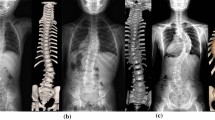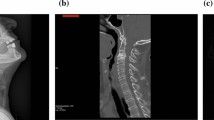Abstract
Background
Williams–Beuren syndrome is a rare multisystemic genetic disorder with an incidence of 1 in 7,500 live births. Because these children often have scoliosis, they undergo routine radiographic examinations of the spine. During these examinations we have found many children with supernumerary lumbar ribs arising from the first lumbar vertebra, often associated with lumbosacral transitional vertebrae.
Objective
To describe the incidence of supernumerary ribs and transitional vertebrae in children with Williams–Beuren syndrome and compare it to the incidence in a general population. Our hypothesis is that these findings are common, but they have not been described in the literature concerning Williams–Beuren syndrome.
Materials and methods
From January 2015 to October 2021, 308 patients (138 male) with Williams–Beuren syndrome were treated at our hospital. Of these, 106 (47 male) underwent diagnostic imaging, mostly for suspected scoliosis. Panoramic radiographs of the whole spine were performed in 88 patients and radiographs of regions of the spine, chest radiographs, CT, MRI or fluoroscopy in 18 patients. We retrospectively analysed the images concerning the number of ribs and vertebrae. We correlated the frequency of lumbar ribs and transitional vertebrae in comparison to a general population as described in the literature.
Results
After exclusions for insufficient imaging, we analysed imaging in 91 patients. Of these, 67 patients (73.6%) had 13 ribs, of which 85% were located on both sides, 9% on the right and 6% on the left side. Of the 67 patients with supernumerary lumbar ribs, 38 (57%) also had transitional vertebrae.
Conclusion
Supernumerary lumbar ribs arising from the first lumbar vertebra, often accompanied by lumbosacral transitional vertebrae, are common in children with Williams–Beuren syndrome.

Similar content being viewed by others
References
Strømme P, Bjørnstad PG, Ramstad K (2002) Prevalence estimation of Williams syndrome. J Child Neurol 17:269–271
Pober BR (2010) Williams-Beuren syndrome. N Engl J Med 362:239–252
Collins RT II (2018) Cardiovascular disease in Williams syndrome. Curr Opin Pediatr 30:609–615
Pankau R, Partsch CJ, Gosch A et al (1992) Statural growth in Williams-Beuren syndrome. Eur J Pediatr 151:751–755
Pober BR, Morris CA (2007) Diagnosis and management of medical problems in adults with Williams-Beuren syndrome. Am J Med Genet C Semin Med Genet 145c:280–290
Kaplan P, Kirschner M, Watters G, Costa MT (1989) Contractures in patients with Williams syndrome. Pediatrics 84:895–899
Morris CA, Braddock SR, Council on Genetics (2020) Health care supervision for children with Williams syndrome. Pediatrics 145:e20193761
Pankau R, Gosch A, Wessel A, Partsch CJ (2015) Das Williams-Beuren-syndrom [The Williams-Beuren syndome]. University Communications, Munich University of Applied Sciences
Aly I, Chapman JR, Oskouian RJ et al (2016) Lumbar ribs: a comprehensive review. Childs Nerv Syst 32:781–785
Davran R, Bayarogullari H, Atci N et al (2017) Congenital abnormalities of the ribs: evaluation with multidetector computed tomography. J Pak Med Assoc 67:178–186
Aignătoaei AM, Moldoveanu CE, Căruntu ID et al (2018) Incidental imaging findings of congenital rib abnormalities — a case series and review of developmental concepts. Folia Morphol 77:386–392
Pionnier R, Depraz A (1956) [Congenital rib abnormalities; statistical study of 10,000 radiographs]. Radiol Clin 25:170–186
Steiner HA (1943) Roentgenologic manifestations and clinical symptoms of rib abnormalities. Radiology 40:175–178
Adibatti M, Asha K (2015) Lumbarisation of the first sacral vertebra a rare form of lumbosacral transitional vertebra. Int J Morphol 33:48–50
Garg B, Mehta N, Goyal A et al (2021) Variations in the number of thoracic and lumbar vertebrae in patients with adolescent idiopathic scoliosis: a retrospective, observational study. Int J Spine Surg 15:359–367
Beuren AJ, Apitz J, Harmjanz D (1962) Supravalvular aortic stenosis in association with mental retardation and a certain facial appearance. Circulation 26:1235–1240
Williams JC, Barratt-Boyes BG, Lowe JB (1961) Supravalvular aortic stenosis. Circulation 24:1311–1318
Lightwood R (1932) A case of dwarfism and calcinosis: associated with widespread arterial degeneration. Arch Dis Child 7:193–208
Fanconi G (1951) [Chronic disorders of calcium and phosphate metabolism in children]. Schweiz Med Wochenschr 81:908–913
Damasceno ML, Cristante AF, Marcon RM, Barros Filho TE (2014) Prevalence of scoliosis in Williams-Beuren syndrome patients treated at a regional reference center. Clinics 69:452–456
Morris CA et al (1993) Williams syndrome. In: Adam MP, Ardinger HH, Pagon RA et al (eds) GeneReviews. University of Washington, Seattle
Kruszka P, Porras AR, de Souza DH et al (2018) Williams-Beuren syndrome in diverse populations. Am J Med Genet A 176:1128–1136
Game X, Panicker J, Fowler CJ (2010) Williams-Beuren syndrome. N Engl J Med 362:1449 (author reply 1450)
Morris CA, Pani AM, Mervis CB et al (2010) Alpha 1 antitrypsin deficiency alleles are associated with joint dislocation and scoliosis in Williams syndrome. Am J Med Genet C Semin Med Genet 154c:299–306
Spencer HT, Gold ME, Hresko MT (2014) Abnormal rib count in scoliosis surgery: impact on the reporting of spinal fusion levels. J Child Orthop 8:497–503
Hu Z, Zhang Z, Zhao Z et al (2016) A neglected point in surgical treatment of adolescent idiopathic scoliosis: variations in the number of vertebrae. Medicine 95:e4682
Struthers J (1874) Variations of the vertebrae and ribs in man. J Anat Physiol 9:17–96
Cumming J (1926) Lumbar rib of unrecorded type. Br Med J 1:55
Bagnall KM, Harris PF, Jones PR (1984) A radiographic study of variations of the human fetal spine. Anat Rec 208:265–270
Chernoff N, Rogers JM (2004) Supernumerary ribs in developmental toxicity bioassays and in human populations: incidence and biological significance. J Toxicol Environ Health B Crit Rev 7:437–449
Taslimi MM, Glass BA (1990) Supernumerary ribs and vertebrae in trisomy 9 syndrome. Prenat Diagn 10:481
Gedikbasi A, Yararbas K, Yildirim G et al (2009) Prenatal diagnosis of VACTERL syndrome and partial caudal regression syndrome: a previously unreported association. J Clin Ultrasound 37:464–466
Hershkovitz R (2008) Prenatal diagnosis of isolated abnormal number of ribs. Ultrasound Obstet Gynecol 32:506–509
Nakajima A, Usui A, Hosokai Y et al (2014) The prevalence of morphological changes in the thoracolumbar spine on whole-spine computed tomographic images. Insights Imaging 5:77–83
Erken E, Ozer HT, Gulek B, Durgun B (2002) The association between cervical rib and sacralization. Spine 27:1659–1664
Lian J, Levine N, Cho W (2018) A review of lumbosacral transitional vertebrae and associated vertebral numeration. Eur Spine J 27:995–1004
Author information
Authors and Affiliations
Corresponding author
Ethics declarations
Conflicts of interest
None
Additional information
Publisher’s note
Springer Nature remains neutral with regard to jurisdictional claims in published maps and institutional affiliations.
Rights and permissions
Springer Nature or its licensor holds exclusive rights to this article under a publishing agreement with the author(s) or other rightsholder(s); author self-archiving of the accepted manuscript version of this article is solely governed by the terms of such publishing agreement and applicable law.
About this article
Cite this article
Schmitz, A., Reutershahn, E., Seiffert, P. et al. First description of frequent occurrence of supernumerary lumbar ribs and transitional vertebrae in children with Williams–Beuren syndrome. Pediatr Radiol 53, 244–248 (2023). https://doi.org/10.1007/s00247-022-05493-6
Received:
Revised:
Accepted:
Published:
Issue Date:
DOI: https://doi.org/10.1007/s00247-022-05493-6




